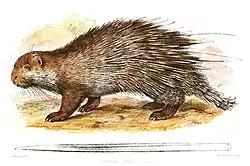List of hystricids
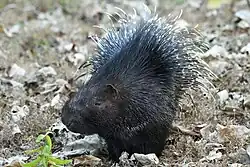
Hystricidae is a family of mammals in the order Rodentia and part of the Phiomorpha parvorder. Members of this family are called hystricids or Old World porcupines. They are found in Southern Europe, the Levant, Africa, India, and Southeast Asia, and can be found in shrublands, grasslands, forests and savannas, though some species have particular habitat and dietary requirements. They range in size from the long-tailed porcupine, at 48 cm (19 in) plus a 23 cm (9 in) tail, to the crested porcupine, at 93 cm (37 in) plus a 17 cm (7 in) tail. Hystricids are primarily herbivores and eat grasses, bulbs, tubers, fruit, bark, and roots, though insects and carrion are occasionally eaten. No hystricids have population estimates, and none are categorized as an endangered species or critically endangered.
The eleven extant species of Hystricidae are divided into three genera: Atherurus consists of two species, the African and Asiatic brush-tailed porcupine, Hystrix contains eight species of porcupines in three subgenera, and Trichys consists of a single species, the long-tailed porcupine. At least eight extinct prehistoric hystricid species have been discovered, with the most recent new description of an extinct species occurring in 2023.[1]
Conventions
| Conservation status | |
|---|---|
| EX | Extinct (0 species) |
| EW | Extinct in the wild (0 species) |
| CR | Critically endangered (0 species) |
| EN | Endangered (0 species) |
| VU | Vulnerable (1 species) |
| NT | Near threatened (0 species) |
| LC | Least concern (10 species) |
| Other categories | |
| DD | Data deficient (0 species) |
| NE | Not evaluated (0 species) |
The author citation for the species or genus is given after the scientific name; parentheses around the author citation indicate that this was not the original taxonomic placement. Conservation status codes listed follow the International Union for Conservation of Nature (IUCN) Red List of Threatened Species. Ranges are based on the IUCN Red List data for that species.
Classification
Hystricidae is a family consisting of eleven species in three genera.
- Family Hystricidae
Hystricids
The following classification is based on the taxonomy described by the reference work Mammal Species of the World (2005), with augmentation by generally accepted proposals made since using molecular phylogenetic analysis, as supported by both the IUCN and the American Society of Mammalogists.[2]
| Common name | Scientific name and subspecies | Range | Size and ecology | IUCN status and estimated population |
|---|---|---|---|---|
| African brush-tailed porcupine
|
A. africanus (J. E. Gray, 1842) |
Central Africa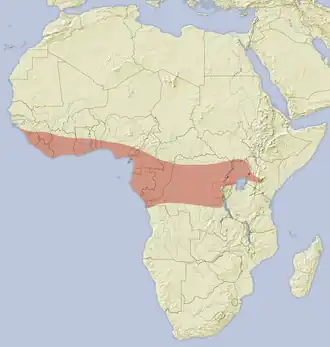
|
Size: 36–60 cm (14–24 in) long, plus 10–26 cm (4–10 in) tail[3] Habitat: Forest[4] Diet: Vegetation, bark, roots, tubers, and fruit, as well as cultivated crops, insects, and carrion[5] |
LC
|
| Asiatic brush-tailed porcupine
|
A. macrourus (Linnaeus, 1758) |
Southeast Asia, southern China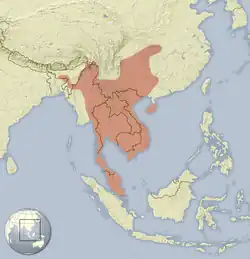
|
Size: 38–57 cm (15–22 in) long, plus 16–20 cm (6–8 in) tail[6] Habitat: Forest, shrubland[7] Diet: Vegetation, bark, roots, tubers, and fruit, as well as cultivated crops, insects, and carrion[5] |
LC
|
| Common name | Scientific name and subspecies | Range | Size and ecology | IUCN status and estimated population |
|---|---|---|---|---|
| Cape porcupine
|
H. africaeaustralis Peters, 1852 Two subspecies
|
Southern Africa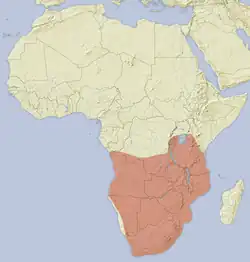
|
Size: 63–81 cm (25–32 in) long, plus 10–13 cm (4–5 in) tail[8] Habitat: Savanna, shrubland, grassland[9] Diet: Bark, roots, tubers, rhizomes, bulbs, fruit, and cultivated crops, occasionally insects, small vertebrates, and carrion[10] |
LC
|
| Crested porcupine
|
H. cristata (Linnaeus, 1758) |
Africa, Italy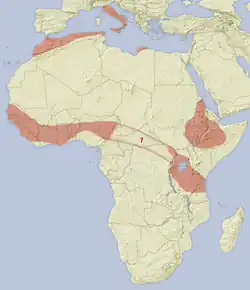
|
Size: 45–93 cm (18–37 in) long, plus 6–17 cm (2–7 in) tail[11] Habitat: Forest, savanna, shrubland, grassland, rocky areas[12] Diet: Bark, roots, tubers, rhizomes, bulbs, fruit, and cultivated crops, as well as carrion[10] |
LC
|
| Indian crested porcupine
|
H. indica Kerr, 1792 |
The Levant and south Asia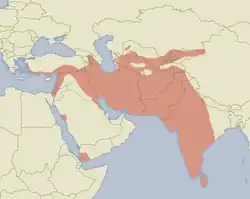
|
Size: 45–93 cm (18–37 in) long, plus 6–17 cm (2–7 in) tail[13] Habitat: Forest, shrubland, grassland[14] Diet: Bark, roots, tubers, rhizomes, bulbs, fruit, and cultivated crops, as well as carrion[10] |
LC
|
| Malayan porcupine
|
H. brachyura (Linnaeus, 1758) Five subspecies
|
China, Nepal, Malaysia, Indonesia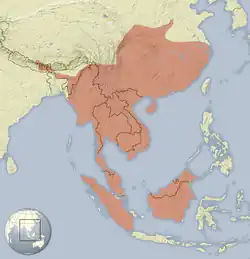
|
Size: 45–93 cm (18–37 in) long, plus 6–17 cm (2–7 in) tail[15] Habitat: Forest, shrubland, grassland[16] Diet: Bark, roots, tubers, rhizomes, bulbs, fruit, and cultivated crops, as well as carrion[10] |
LC
|
| Philippine porcupine
|
H. pumila (Günther, 1879) |
Palawan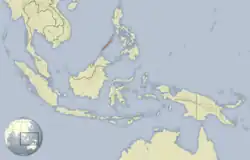
|
Size: 45–67 cm (18–26 in) long, plus 6–19 cm (2–7 in) tail[15] Habitat: Forest, shrubland[17] Diet: Bark, roots, tubers, rhizomes, bulbs, fruit, and cultivated crops, as well as carrion[10] |
VU
|
| Sumatran porcupine
|
H. sumatrae (Lyon, 1907) |
Sumatra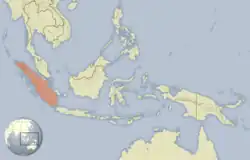
|
Size: 45–56 cm (18–22 in) long, plus 9–11 cm (4–4 in) tail[6] Habitat: Forest, shrubland[18] Diet: Bark, roots, tubers, rhizomes, bulbs, fruit, and cultivated crops, as well as carrion[10] |
LC
|
| Sunda porcupine
|
H. javanica (F. Cuvier, 1823) |
Java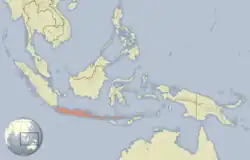
|
Size: 45–66 cm (18–26 in) long, plus 6–17 cm (2–7 in) tail[11] Habitat: Forest, shrubland[19] Diet: Bark, roots, tubers, rhizomes, bulbs, fruit, and cultivated crops, as well as carrion[10] |
LC
|
| Thick-spined porcupine
|
H. crassispinis (Günther, 1877) |
Borneo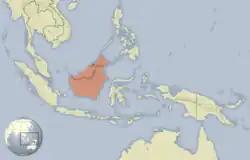
|
Size: 45–67 cm (18–26 in) long, plus 6–19 cm (2–7 in) tail[15] Habitat: Forest[20] Diet: Bark, roots, tubers, rhizomes, bulbs, fruit, and cultivated crops, as well as carrion[10] |
LC
|
| Common name | Scientific name and subspecies | Range | Size and ecology | IUCN status and estimated population |
|---|---|---|---|---|
| Long-tailed porcupine
|
T. fasciculata (Shaw, 1801) |
Brunei, Indonesia, Malaysia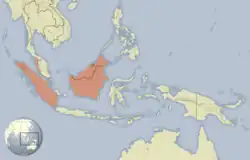
|
Size: 35–48 cm (14–19 in) long, plus 17–24 cm (7–9 in) tail[3] Habitat: Forest[21] Diet: Seeds, vegetation from trees, shrubs, and bamboo[3] |
LC
|
References
- ^ "Fossilworks: Hystricidae". Paleobiology Database. University of Wisconsin–Madison. Archived from the original on January 22, 2025. Retrieved July 19, 2025.
- ^ Wilson, Reeder, pp. 1543-1544
- ^ a b c Barthelmess, p. 323
- ^ a b Hoffmann, M.; Cox, N. (2016). "Atherurus africanus". IUCN Red List of Threatened Species. 2016: e.T2353A22231384. doi:10.2305/IUCN.UK.2016-3.RLTS.T2353A22231384.en. Retrieved July 20, 2025.
- ^ a b Nowak, p. 1645
- ^ a b Barthelmess, p. 324
- ^ a b Molur, S. (2020). "Atherurus macrourus". IUCN Red List of Threatened Species. 2020: e.T2354A166518819. doi:10.2305/IUCN.UK.2020-1.RLTS.T2354A166518819.en. Retrieved July 20, 2025.
- ^ Barthelmess, p. 327
- ^ a b Cassola, F. (2017) [errata version of 2016 assessment]. "Hystrix africaeaustralis". IUCN Red List of Threatened Species. 2016: e.T10748A115099085. doi:10.2305/IUCN.UK.2016-3.RLTS.T10748A22232321.en. Retrieved July 20, 2025.
- ^ a b c d e f g h Nowak, p. 1647
- ^ a b Barthelmess, p. 326
- ^ a b Amori, G.; De Smet, K. (2016). "Hystrix cristata". IUCN Red List of Threatened Species. 2016: e.T10746A22232484. doi:10.2305/IUCN.UK.2016-2.RLTS.T10746A22232484.en. Retrieved July 20, 2025.
- ^ Barthelmess, p. 328
- ^ a b Amori, G.; Hutterer, R.; Kryštufek, B.; Yigit, N.; Mitsainas, G.; Palomo, L. J. (2021) [amended version of 2016 assessment]. "Hystrix indica". IUCN Red List of Threatened Species. 2021: e.T10751A197516522. doi:10.2305/IUCN.UK.2021-1.RLTS.T10751A197516522.en. Retrieved July 20, 2025.
- ^ a b c Barthelmess, p. 325
- ^ a b Lunde, D.; Aplin, K.; Molur, S. (2017) [errata version of 2016 assessment]. "Hystrix brachyura". IUCN Red List of Threatened Species. 2016: e.T10749A115099298. doi:10.2305/IUCN.UK.2016-3.RLTS.T10749A22232129.en. Retrieved July 20, 2025.
- ^ a b Clayton, E. (2018). "Hystrix pumila". IUCN Red List of Threatened Species. 2018: e.T10753A22231557. doi:10.2305/IUCN.UK.2018-1.RLTS.T10753A22231557.en. Retrieved July 20, 2025.
- ^ a b Amori, G.; Aplin, K. (2016). "Hystrix sumatrae". IUCN Red List of Threatened Species. 2016: e.T10754A22231673. doi:10.2305/IUCN.UK.2016-2.RLTS.T10754A22231673.en. Retrieved July 20, 2025.
- ^ a b Aplin, K. (2016). "Hystrix javanica". IUCN Red List of Threatened Species. 2016: e.T10752A22231749. doi:10.2305/IUCN.UK.2016-2.RLTS.T10752A22231749.en. Retrieved July 20, 2025.
- ^ a b Cassola, F. (2016). "Hystrix crassispinis". IUCN Red List of Threatened Species. 2016: e.T10750A22232051. doi:10.2305/IUCN.UK.2016-2.RLTS.T10750A22232051.en. Retrieved July 20, 2025.
- ^ a b Aplin, K. (2017). "Trichys fasciculata". IUCN Red List of Threatened Species. 2017: e.T22132A22232753. doi:10.2305/IUCN.UK.2017-2.RLTS.T22132A22232753.en. Retrieved July 20, 2025.
Sources
- Barthelmess, Erika L. (2016). Wilson, D. E.; Lacher, T. E.; Mittermeier, R. A. (eds.). Handbook of the Mammals of the World. Vol. 6. Lagomorphs and Rodents I. Barcelona: Lynx Edicions. ISBN 978-84-941892-3-4.
- Nowak, Ronald M. (1999). Walker's Mammals of the World. Vol. 2 (6th ed.). Johns Hopkins University Press. ISBN 978-0-8018-5789-8.
- Woods, Charles A.; Kilpatrick, C. William (2005). Wilson, Don E.; Reeder, DeeAnn M. (eds.). Mammal Species of the World. Vol. 2 (3rd ed.). Johns Hopkins University Press. ISBN 978-0-8018-8221-0.
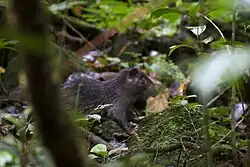
.jpg)
.jpg)
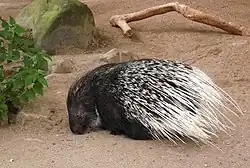
.jpg)
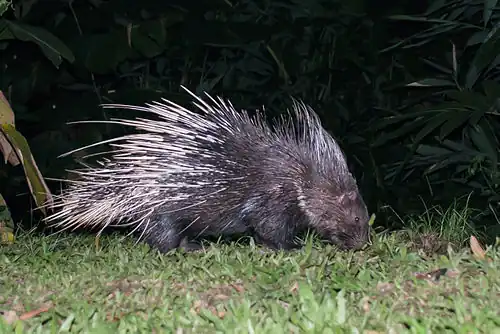
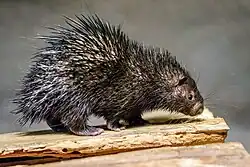
.jpg)
